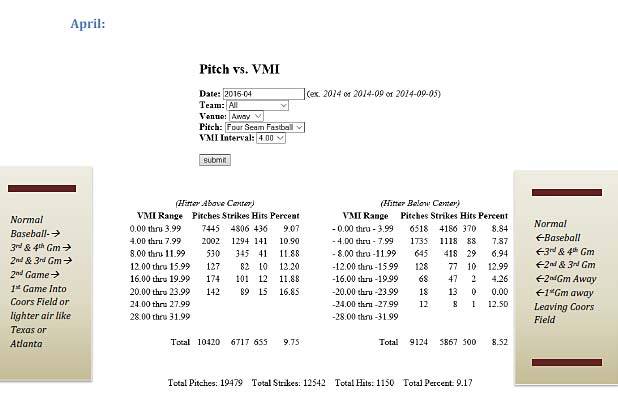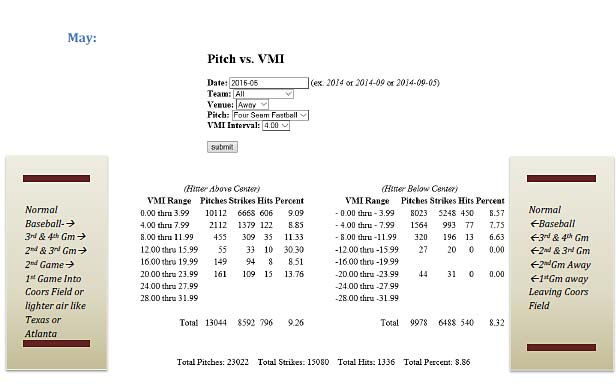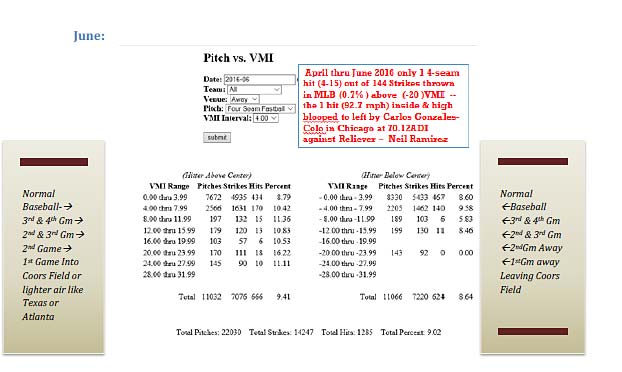

Posted: 2017-02-15 08:52:53 (ET) [ 845 views ]
The week before the MLB 2016 winter meetings, Patrick Saunders' wrote an article in The Denver Post entitled "Taking up arms for 2017," a revelation of the Rockies' current pitching philosophy. While writing about "dig deeper" into the philosophy, a discussion about the overall plan from the minors throughout the majors was revealed. The philosophy to get young pitchers to pitch the right way starting in rookie league Grand Junction and continuing to the Triple A level in Albuquerque is impressive; digging deep enough (in my opinion) for typical major league teams. Digging deeper yet is necessary to take the Rockies to an elite level. It is evident the Rockies coaching and management are hitting on all the right philosophies for MLB pitchers. The only thing that is missing from the current pitching philosophy is "when." But "when" is a pretty big subject due to the thin air of Colorado and the variations of air resistance around the country. The Rockies hitters fatten their averages all in one win at Coors Field, and in the next game the pitchers struggle to keep the visiting team from fattening their averages. "When" is huge on the road as well, because the Rockies pitchers lose their precision at the same time as the hitters can no longer hit as frequently as the balance of the league (especially the fastball) to provide run support for the pitchers, so the season end brings the same result. The data is both consistent and clear for MLB hitters' production on the four-seamer in an unfamiliar environment.
In terms of pitching well at Coors Field, it matters greatly if one is talking about Coors Field on the first day of a series or the second day of a series, because each day's exposure to the movement on pitches changes the hitters' preparation for the next game. It also matters greatly who the opponent is and what movement their hitters are used to seeing recently on each pitch. First game of the series for the opponent? Third game?
In terms of hitting well on the road and even pitching well on the road, questions still need to be answered before knowing how to best pitch the opponent. Where is the stadium? How much additional movement (exactly) will the opposing pitcher have? Is this the first game of the road trip, or have the Rockies hitters already adjusted, say half-way to today's conditions because of their first road series? All these issues will affect run support for the Rockies pitchers.
Questions such as the following are appropriate given the team's historical record on the road. While trying to pinpoint the way in which to improve the team during the off-season, consider these issues. Are the Rockies pitchers out of their element and adjusting to the air pushing the pitches further "out of or into" the zone? The data is pretty clear on this as being an important issue in winning. Are the opposing hitters used to more movement based on where they played their last series? If so, some pitches will be more effective today than they may be on another day--even in Coors Field. Why? Because, (say it's on the road at sea level) if the air is allowing good movement today, then there will be a greater distance for the hitter to cover with the barrel, between the upward lifting fastball and the sinker than if the air was allowing only average movement (say in the Midwest). Remember, the hitter must set himself for a fastball and then must quickly alter his swing to get down to the sinker, etc. Mix in Coors Field where--at a similar speed, and the same pitcher release point--the distance between the 4-seamer at the plate and the sinker at the plate is the shortest distance between the two spots in MLB, due to straighter pitches in the thin air. See http://i.imgur.com/ENzND5r.gif So a hitter has less distance to cover in the time allowed to alter his swing. Now, imagine eight, or so, other types of pitches the hitter must deal with in environments allowing greater movement than in Coors Field. This is the reason that hitters are relatively great in Coors Field and pitchers will always struggle and vice-versa for road games. For Rockies Management: digging deeper yet in philosophy is extremely important. Dan O'Dowd brought in a couple of now infamous (in Colorado) pitchers who could throw certain pitches, and although those two did not work out well, he continued to study which pitches actually worked best in Coors Field. He found that the sinker, cutter and two-seamer worked well most of the time, but never discovered the answer as to "when." The current administration is wondering about it, but feel all pitches will work if a "good" pitch is made. The problem is always going to be too straight a pitch in Coors Field to be "good" and too different on the road to be "accurate." So throwing out the pitch-mix understanding that Dan O'Dowd began is throwing out the baby with the bath water. In other words, Jeff Bridich and Bud Black should keep all their accumulated knowledge, but dig deeper, otherwise the Rockies will continue to bounce from philosophy to philosophy forever.
I agree with Wiley's statement that "it really isn't that much different than any other place." Coors Field really isn't--but "when" is still an extremely big question in terms of winning both at home and on the road. If the Rockies big bats come out only at Coors Field and they win by 15 runs, it skews the batting averages dramatically for only 1 win. Then, the next day they can easily lose by 15 runs, which skews the earned run averages's dramatically. By season's end, each pitcher has collected enough of these big days against to skew his era and look worse than he really is. Then, of course, the Rockies leave Coors Field and can't provide run support for their pitchers whom have held the home team to, say, two runs, losing the game, and again, the era's and batting averages are skewed the opposite directions. But after a few games on a home stand at Coors Field, the scores settle down as both teams get used to the local pitch movement--so the games are much like in other locations. As for road trips, after several games on the same trip, the Rockies become more like other teams and hit and pitch more like a typical team, but normally without much confidence to allow them to compete equally.
A pitcher for Colorado must know how to get the ball around the hitter's bat "today" regardless of where he's pitching, and that changes with the air density and with the hitters' exposure to it. Since the air density is extremely different in all locations, temperatures and humidity levels--see www.baseballvmi.com, it must be put on a scale so that the pitcher will know in advance not only how much movement he'll have today, but also how much movement the hitters he'll face today will be used to seeing. Sometimes he'll dial up the worst case scenario and there will be nothing he can do about it. That is "when" he needs to be (as was pointed out in the article) "tough enough" to deal with it.
All the MLB performances can be divided into air density and familiarity categories for each MLB player and team, so the Rockies can dig deeper yet and see the results. The management is doing everything right for a typical team--analyzing all the individual players correctly as far as anyone outside the organization can tell. However, team psychology and team analysis are different subjects from personnel and contract decisions. MLB teams have never had to dig deep into the environmental pitch movement transitions because they all play in much more similar environments, so Rockies management needs to dig deeper into this subject, because they won't find good Colorado analysis within the experienced baseball men in the league. If the Rockies continue to keep this subject under wraps, they will continue to be only an entertainment venue at the expense of both winning baseball seasons and good individual MLB careers which have not and will not end in the Hall Of Fame (See Larry Walker, Todd Helton, Troy Tulowitzke and Nolan Arenado, etc., etc.). Also, the Rockies will waste a very intelligent manager and general manager--again.
If the air being too light in Coors Field to keep the visitor from pounding the ball against the pitchers is the problem, then the air must be addressed, not who's doing the pitching. If the air being too heavy at other locations for the hitters to give run support to the pitchers when first leaving Coors Field is the problem, then the air must be addressed, not who's doing the hitting. If it ain't broke don't fix it. If it is broke, don't fix the wrong thing.
Below I have attached a display of the first half of the 2016 season, showing the performance of all the hitters in MLB against all pitchers throwing the four-seam fastball. This pitch is the most used pitch in the league. Notice the hit per strike thrown percentage when the air is most unfamiliar:



No one who played in Coors Field over a 3 month period and to whom 143 other 4-seam strikes were presented, got a hit in the entire first half of the 2016 MLB season in the first game after leaving Coors Field, unless they transitioned back to their home field. Normally, MLB players would produce an average of 13 hits if presented with 143 strikes of this pitch-type.
Coors Field production and MLB exposure to the straightest pitching in the league creates the most havoc for both pitchers and hitters in the history of Major League Baseball. The data in the tables above identifies the period it takes for a player to conform to the movement the environment provides. Since teams normally play a three game series in an environment, then three games is all that is necessary.
The second lightest air in MLB over the entire season is found in Texas due to the field elevation, hot temperatures and higher humidity levels. This too causes teams similar havoc--even if lesser. Atlanta is the third lightest air over the entire season. Kansas City and Arizona create havoc in a similar manner, as well. Kansas City is very cold in the Spring and Arizona closes its stadium in the heat of the summer, so it depends on the time of the year and the day to day weather as to how disruptive the conformity may be.
On the other end of the scale, as teams travel into the heavy air of the very cold mid-west, or into sea-level air for a series, it is also obvious by the data presented above, that when moving back into lighter air and lesser movement after three days or so of exposure to this primary pitch, the players are much more effective against it.
The logical conclusion is that players, whose home stadium is in an environment providing lesser movement for the pitchers become “exposure deprived.” And, players, whose home stadium is in an environment providing greater movement for the pitchers become “exposure rich.”
At some point in the future, I will be able to demonstrate this phenomenon in a simulated environment. Until then, this is the best proof of concept in favor of a pressurized or hyperbaric hitting cage (see www.airchamberfacilities.com ) to provide those “exposure deprived” hitters and pitchers a place in which to balance their true talent against the “exposure rich.”
Although it is too soon to tell what the outcome may be, the Colorado Rockies traded a top quality pitcher in Eddie Butler to the Chicago Cubs. This may come back to haunt them because now they must start the process of bringing a new young pitcher up “the right way” and also must face Eddie Butler when he has better movement on the pitches in cold Chicago. While looking at Butler’s data for 2016, he was very good in such environments, but did not pitch as many outings in good movement as did his Colorado pitching partners. In my opinion, the Rockies management did not look at my data which shows the environmental splits and they undervalued Eddie Butler. “When” is a very important question and time may tell that they made a mistake.
---------------------------------
Clifton Neeley, Author, Baseball Unraveled - see Amazon.Com
and Founder, www.BaseballVMI.com

© 2020 Air Resistance Technologies, Inc., All Rights Reserved.
BaseballVMI.com, 1326 51st Avenue, Greeley, CO. 80634